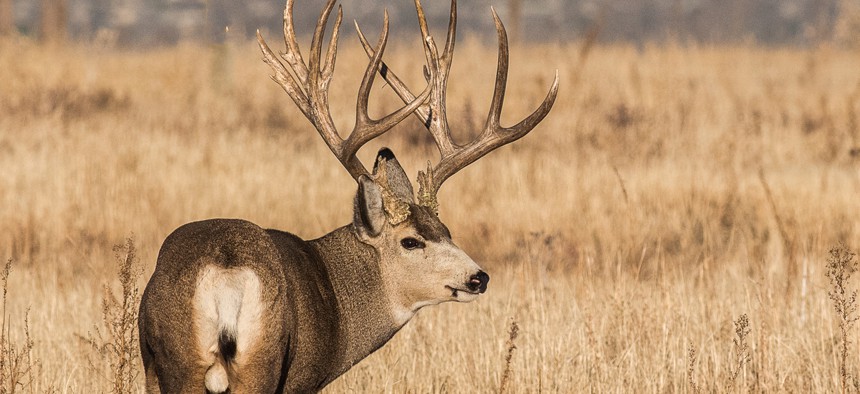There Are No Zombie Deer in Nevada. State Officials Want to Keep It That Way

Chronic wasting disease, an always-fatal nervous system disorder that affects animals in the deer family, can take years to manifest in physical symptoms. Shutterstock

Connecting state and local government leaders
Wildlife officials in Nevada are committed to preventing chronic wasting disease from infecting state populations of deer.
As Halloween approaches, wildlife officials in Nevada are doing their best to protect their state from populations of stumbling, drooling “zombie deer.”
The spooky-sounding name is given to deer infected with chronic wasting disease, or CWD, an always-fatal and highly contagious nervous system disorder that affects deer, elk, moose and reindeer. The disease is transmitted through direct contact between animals or animal fluids, including saliva and feces, and is the result of naturally occurring proteins called prions that become deformed and resist being broken down by the body.
Over time, damaged prions begin harming an animal’s nervous system, leading to lethargy, emaciation, extreme thirst and difficulty walking and running. There is no cure or treatment. The disease can take up to two years to manifest in physical symptoms, so confirmed sightings of infected animals are rare, as they typically are killed by predators, cars or hunters before they start to appear sick.
The disease can devastate populations of mule deer, which had been on the decline in Nevada since the 1980s. Those numbers stabilized in recent years, and wildlife officials hope to continue that trend.
“We really want to keep increasing our mule deer populations,” said Ashley Sanchez, a spokeswoman for the state Department of Wildlife. “This is important, as it is our duty to protect and manage our wildlife populations. With Nevada being 90 percent public land, we have plenty of space to expand our mule deer populations.”
To date, chronic wasting disease has been confirmed in wild or captive deer in three Canadian provinces, Norway, South Korea and 25 states, including Utah, which borders Nevada on the east. To prevent hunters from unknowingly spreading the disease, state legislators in May passed a law forbidding the transport of certain parts of animal carcasses (namely the spinal column, brain tissue and head) across state lines.
Wildlife officials are trying to bolster those efforts by monitoring the in-state population of deer at voluntary weekend checkpoints, located at truck stops along highways in the eastern part of the state. The checkpoints, where biologists take samples from deer carcasses shot by hunters, began on Oct. 5. Eighty-eight samples were collected that first weekend, all of them negative.
“We take a sample from the deer and then take them to our lab. It takes about a week or two to get the results,” Sanchez said.”If we were to detect CWD, we would contact the hunter immediately and ask a series of questions. A big goal would be locating exactly where that animal was harvested.”
The state would properly dispose of the carcass, then create a long-term action plan based on recommendations from the Western Association of Fish and Wildlife Agencies.
The voluntary checkpoints will continue through at least the end of October, though hunters who can’t visit one have other options for testing, Sanchez said.
“They can bring the head of their animal to our office—but call ahead of time so we’re ready for it,” she said. “You can also request that your taxidermist submit the sample for you.”
To date, chronic wasting disease poses no threat to humans, though both federal and state officials urge hunters not to eat meat harvested from animals exhibiting symptoms of the disease. Some research has indicated that primates who repeatedly consume infected meat eventually exhibit changes in brain function, and the World Health Organization recommends keeping “the agents of all known prion diseases out of the human food chain.”
Nationwide, chronic wasting disease has “persisted, spread, and increased in prevalence in nearly every area where it has been introduced,” according to the Chronic Wasting Disease Alliance. Preventing its introduction to new areas is the most effective form of management, and Nevada officials are confident they have a handle on the problem.
“At this point, we don’t expect it in Nevada,” Sanchez said. “We’ve had monitoring efforts in place since the 1990s and it’s never been detected here. But it doesn’t hurt to be careful.”
Kate Elizabeth Queram is a Staff Correspondent for Route Fifty and is based in Washington, D.C.

NEXT STORY: Colorado launches its own Digital Service




